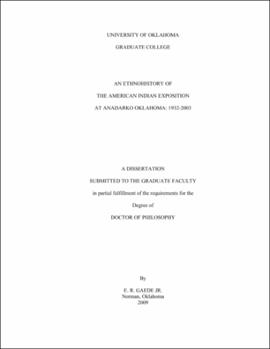| dc.contributor.advisor | Palmer, Jr., Gus | |
| dc.creator | Gaede, Jr., Eldon R. | |
| dc.date.accessioned | 2019-04-27T21:21:47Z | |
| dc.date.available | 2019-04-27T21:21:47Z | |
| dc.date.issued | 2009 | |
| dc.identifier | 99124714502042 | |
| dc.identifier.uri | https://hdl.handle.net/11244/318505 | |
| dc.description.abstract | The American Indian Exposition achieved unprecedented national prominence between its founding in 1932 and its "Glory Years" in the 1940s and 1950s. As a result, Anadarko was proclaimed as the Indian capital of the United States. What strategies did the Exposition's founders implement to garner this status to insure its continued success? Insights gained by this study clarify our understanding of how Oklahoma's Indians, and by extension America's indigenous populations, adjusted to sweeping political, economic and social changes mandated by government agencies in the early 20th century. The American Indian Exposition represents a unique form of American Indian cultural renaissance that began in the early 20th century. My ethnohistory of the American Indian Exposition ameliorates its current obscuration by detailing its emergence, development and influences through firsthand participants' narratives and archival research so that future generations-Indian and non-Indian alike-might appreciate its true significance. | |
| dc.format.extent | 737 pages | |
| dc.format.medium | application.pdf | |
| dc.language | en_US | |
| dc.relation.requires | Adobe Acrobat Reader | |
| dc.subject | Indians of North America--Great Plains--Ethnic identity | |
| dc.subject | Heritage tourism--Oklahoma--Anadarko | |
| dc.title | AN ETHNOHISTORY OF THE AMERICAN INDIAN EXPOSITION AT ANADARKO, OKLAHOMA: 1932-2003 | |
| dc.type | text | |
| dc.type | document | |
| dc.thesis.degree | Ph.D. | |
| ou.group | College of Arts and Sciences::Department of Anthropology | |
